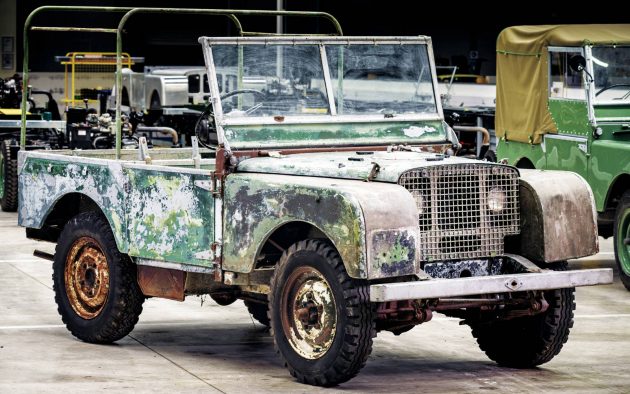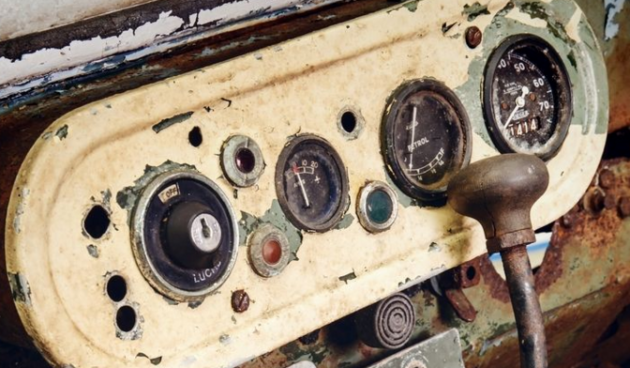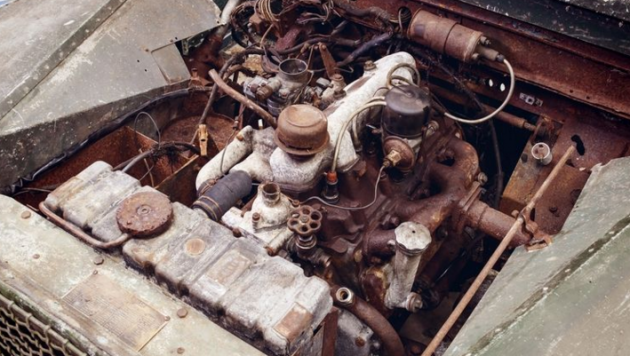Land Rover is celebrating its 70th anniversary, and as such, it set out to find a special way to commemorate it. What better way is there than finding the very first Series 1 truck ever made? The company did just that, finding serial number 1 rotting in a garden not far from where it first rolled off the assembly line. It will be fully restored by Land Rover’s restoration division. You can read the full story here on Car and Driver magazine’s website .
This Land Rover dates back to 1948 and is considered a pre-production prototype. It was used on the car show circuit and later sold off to the general public. It had a number of unique identifiers that set it apart from mass production models, including thicker aluminum panels; galvanized chassis; and a removable rear tub. The Land Rover clearly has been outside for most of its life, which is appropriate – isn’t that what Land Rovers were meant to do?
The Rover is affectionately known as Huey, and interestingly, he spent several years registered as a “static power source” in Wales until the engine seized. I don’t know much about UK culture, but I’m fascinated by the idea that you can march down to the equivalent of the DMV, and tell the nice lady you’re turning your 4×4 into a static power source and to take it off the tax rolls. Whatever the story is, the Rover languished with a few different owners, some of whom intended to restore it, before Land Rover got wind of it and made the acquisition.
As you can see, it has remained surprisingly original. Doesn’t that just blow your mind – that a vehicle made in 1948, with no obvious attempts made to preserve it, can still survive in this condition? Land Rover has confirmed that they don’t intend to over-restore it and will even attempt to preserve its weathered exterior. From then on, it will likely be a showpiece in a museum-style setting, which is an appropriate retirement for a significant Series 1 that has been waiting to come home for many years.






What better way to show how these things last forever then to leave this one as it was found. Make it run and drive and leave the restoration to something else.
Love that the heater valve(?) just appears to be a water spigot handle. Early TRs as well as Sprites and Midgets have a similar setup. Old British stuff just rules.
Seems like kind of a shame to restore it at all. I would rather see it preserved just as it is
I guess the galvanized chassis, and aluminum panels helped with it’s survival. I’ll take versatility over sportiness every time.
If it’s been sitting outside in wet cold British garden since 1968 I’d be surprised if much of the frame has survived in tact, galvanized or not. Nice find. It will leed a pampered life from this point forward.
Steve R
Restoration is the only way to appreciate this, first of many. It is well beyond preservation and the only way to make it last is to make it back to the way it was when it left the assembly line 70 years ago. I hope the resto goes well, and I also hope that they keep it alive with regular workouts…
I am no LR expert , but were the ” mass production units ” not fitted with galvanized chassis ?
I can’t see what the gauges are indicating. give me a hammer…
My neighbour has a 1957 model which he has stripped down. The chassis is not what you expect. It is a box frame where all four sides have been cut or pressed out and the four seams are welded full length with what appears to be an oxy-acetylene torch.
They fatigue around one of the front spring mounts and can be welded again.
As far as I know, the galvanised chassis might have been an option in much later models and down here in Australia, our late model military Land Rovers had galvanised chassis. Some were six-wheel drive.
http://www.channel4.com/programmes/for-the-love-of-cars/episode-guide/series-1 Check out this TV show. The series one featured sold at auction after restoration and fetched a record price. It gives an insight of what’s expected if you want achieve top money.
.
Never saw this model here in the States. Only on National Geo safari type shows. Then I went to England 15 years ago and it seemed every sheep farmer in the “West Country” had one…often looking “well used”. No wonder this one survived in Wales, right across the bay from where I was…
Likely the car was named Huey because of it’s licence plate having HUE on it. The earliest Series One vehicle, before this one was found, is also known as Huey for that reason. As that one is fully restored it makes sense to keep this one looking it’s age. Maybe this one was HUE 165..?